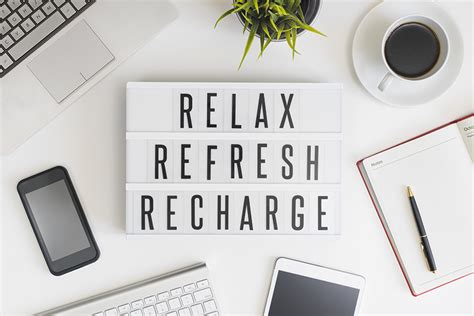In today’s fast-paced, demanding world, it’s crucial to prioritize breaks to maintain well-being and productivity. A well-planned break can significantly enhance cognitive function, boost creativity, and reduce stress levels.

Benefits of Taking Breaks
Research consistently highlights the numerous benefits of regular breaks. According to a study published in the Journal of Applied Psychology, employees who take short breaks every hour report higher levels of engagement and productivity than those who work without breaks.
Other studies have shown that breaks:
- Improve focus and concentration by resetting the brain’s attentional mechanisms
- Enhance creativity by allowing the mind to wander and generate new ideas
- Reduce stress levels by providing a respite from demanding tasks
- Boost mood and increase feelings of well-being
Types of Breaks
There are various types of breaks, each offering unique benefits.
Micro Breaks: These are short, frequent breaks taken throughout the day. They typically last for 5-10 minutes and involve activities like standing up, stretching, or taking a walk. Micro breaks are ideal for maintaining focus and preventing fatigue.
Mini Breaks: Mini breaks are longer than micro breaks and last for 15-30 minutes. They provide an opportunity for relaxation and mental recovery. Activities like reading, listening to music, or engaging in hobbies are suitable for mini breaks.
Extended Breaks: Extended breaks are usually taken during lunch or at the end of the workday. They typically last for 1-2 hours and allow for more substantial recovery. Activities like exercising, socializing, or pursuing personal interests are recommended during extended breaks.
Planning Effective Breaks
To reap the full benefits of breaks, it’s essential to plan them effectively. Consider the following tips:
- Schedule breaks: Set aside specific times in your schedule for breaks and stick to them.
- Choose activities you enjoy: Breaks should be enjoyable and rejuvenating. Choose activities that you find relaxing and stress-relieving.
- Take complete breaks: Avoid checking emails or taking calls during breaks. Use this time to fully disconnect and recharge.
- Use breaks to socialize: If possible, take breaks with colleagues or friends to build relationships and boost morale.
- Experiment with different types of breaks: Find out what works best for you. Experiment with different types of breaks (micro, mini, or extended) and activities to determine what provides the most benefits.
Common Mistakes to Avoid
While breaks are essential, there are some common mistakes to avoid.
- Skipping breaks: Skipping breaks ultimately leads to burnout and reduced productivity.
- Taking short breaks too infrequently: Taking breaks that are too short or infrequent does not provide sufficient time for relaxation and recovery.
- Spending breaks on work-related activities: Using breaks to check emails or respond to calls defeats the purpose of taking a break.
- Feeling guilty about taking breaks: Breaks are not a waste of time. They are an investment in your well-being and productivity.
Table 1: Benefits of Breaks
| Benefit | Description |
|---|---|
| Improved focus and concentration | Breaks help reset attentional mechanisms and improve focus. |
| Enhanced creativity | Breaks allow the mind to wander and generate new ideas. |
| Reduced stress levels | Breaks provide a respite from demanding tasks, reducing stress. |
| Boosted mood and well-being | Breaks help improve overall mood and feelings of well-being. |
Table 2: Types of Breaks
| Type | Duration | Activities |
|---|---|---|
| Micro Break | 5-10 minutes | Standing up, stretching, taking a walk |
| Mini Break | 15-30 minutes | Reading, listening to music, engaging in hobbies |
| Extended Break | 1-2 hours | Exercising, socializing, pursuing personal interests |
Table 3: Tips for Planning Effective Breaks
| Tip | Description |
|---|---|
| Schedule breaks | Set aside specific times in your schedule for breaks. |
| Choose enjoyable activities | Select activities that you find relaxing and stress-relieving. |
| Take complete breaks | Disconnect from work and fully recharge during breaks. |
| Use breaks to socialize | Take breaks with colleagues or friends to build relationships and boost morale. |
| Experiment with different types of breaks | Explore different types of breaks and activities to find what works best for you. |
Table 4: Common Mistakes to Avoid
| Mistake | Description |
|---|---|
| Skipping breaks | Skipping breaks ultimately leads to burnout and reduced productivity. |
| Taking short breaks too infrequently | Breaks that are too short or infrequent do not provide sufficient time for relaxation and recovery. |
| Spending breaks on work-related activities | Using breaks to check emails or respond to calls defeats the purpose of taking a break. |
| Feeling guilty about taking breaks | Breaks are not a waste of time. They are an investment in your well-being and productivity. |
Novel Word: “Breactive”
To further explore the concept of breaks, we introduce the novel word “breactive.” Breactive denotes the state of being highly receptive to new ideas, solutions, and perspectives as a result of taking a break. When we take breaks, our minds become more open and receptive, allowing for greater creativity and problem-solving.
Conclusion
Taking regular breaks is essential for maintaining optimal well-being and productivity. By implementing effective break strategies, we can enhance focus, boost creativity, reduce stress, and improve overall mood. Remember to schedule breaks, choose enjoyable activities, take complete breaks, and avoid common mistakes. By prioritizing breaks, we invest in our physical, mental, and emotional health, enabling us to thrive both personally and professionally.
